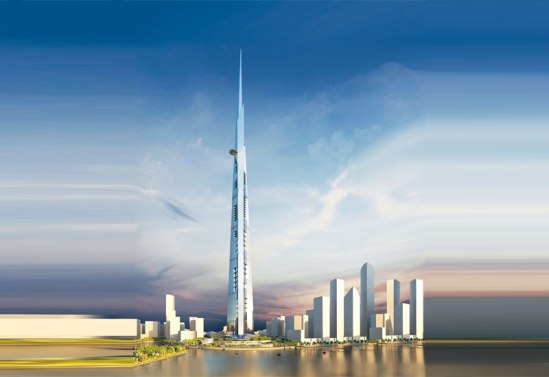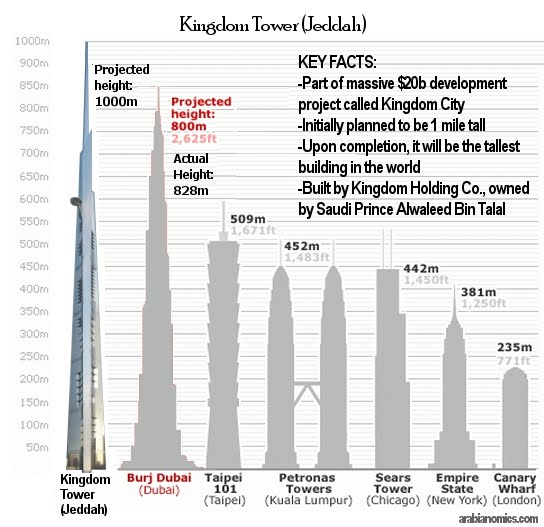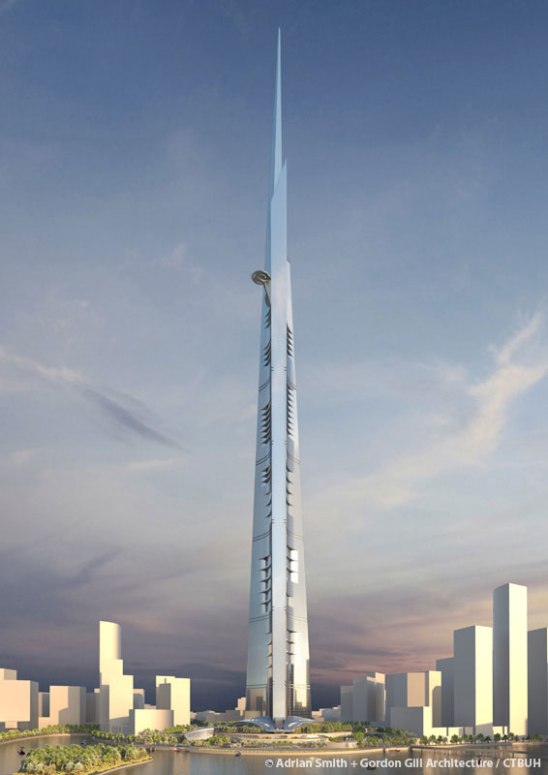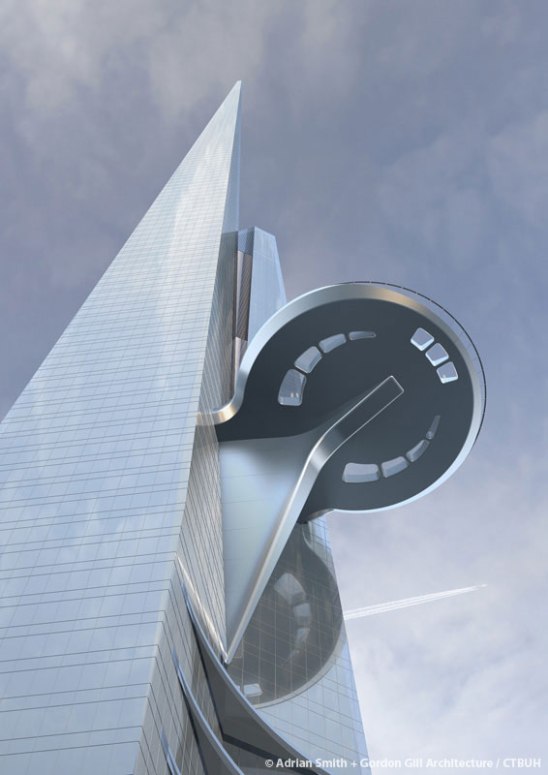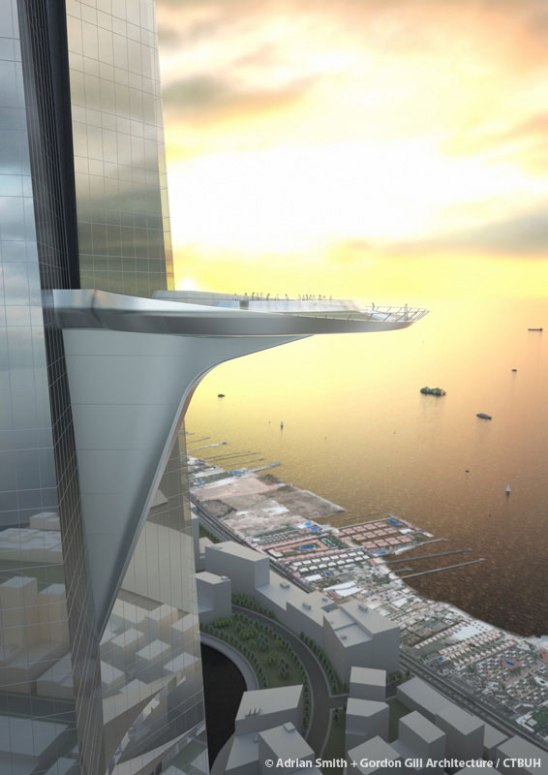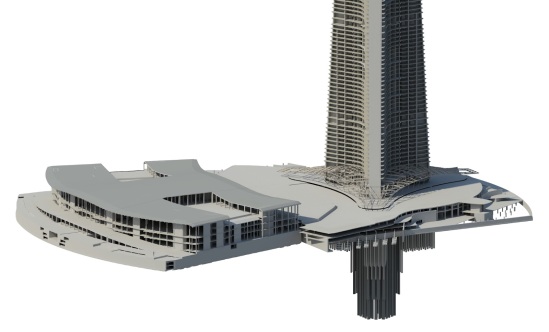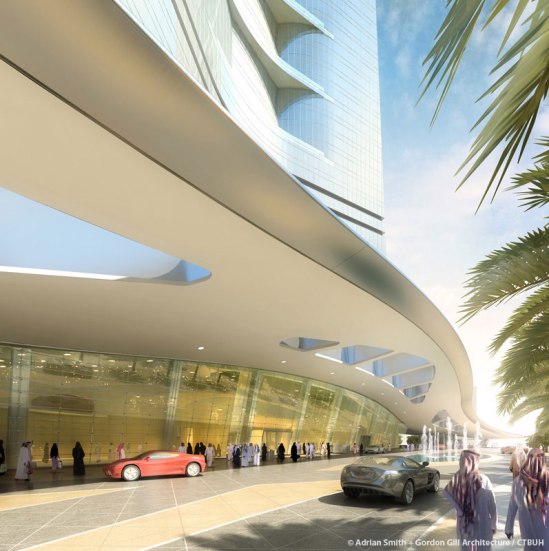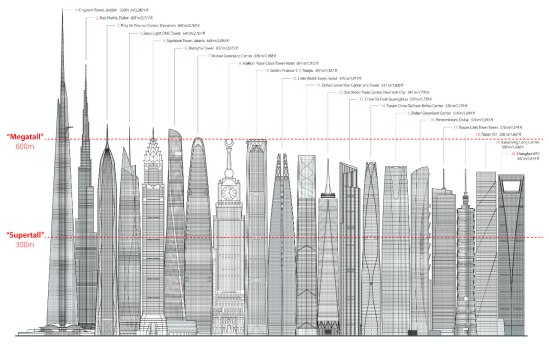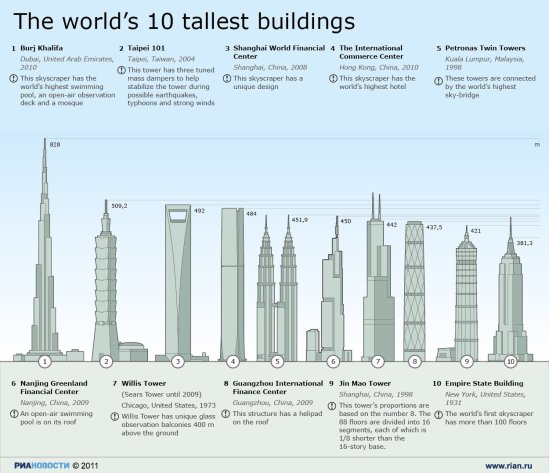Kingdom Tower
Kingdom Tower (Arabic: برج المملكة Burj al Mamlakah), and initially proposed as the Mile-High Tower, (Arabic: برج الميل), is a skyscraper currently under construction in Jeddah, Saudi Arabia, at a preliminary cost of SR4.6 billion (US$1.23 billion). It will be the centrepiece and first phase of a SR75 billion (US$20 billion) proposed development known as Kingdom City that will be located along the Red Sea on the north side of Jeddah. If completed as planned, the tower will reach unprecedented heights, becoming the tallest building in the world, as well as the first structure to reach the one-kilometre-high mark. The tower was initially planned to be 1.6 kilometres (1 mi) high; however, the geology of the area proved unsuitable for a tower of that height. The design, created by American architect Adrian Smith, who also designed Burj Khalifa, incorporates many unique structural and aesthetic features. The creator and leader of the project is Saudi Arabian Prince Al-Waleed bin Talal, the wealthiest Arab in the Middle East, and nephew of King Abdullah. Al-Waleed is the chairman of Kingdom Holding Company (KHC), the largest company in Saudi Arabia, which is a partner in Jeddah Economic Company (JEC), which was formed in 2009 for the development of Kingdom Tower and City. Reception of the proposal has been highly polarized, receiving high praise from some as a culturally significant icon that will symbolize the nation’s wealth and power, while others question its socioeconomic motives, and forecast that it will have negative financial consequences. At over 1,000 meters (3,280 feet) and a total construction area of 530,000 square meters (5.7 million square feet), Expected to cost $1.2 billion to construct, Kingdom Tower will be a mixed-use building featuring a luxury hotel, office space, serviced apartments, luxury condominiums and the world’s highest observatory. Kingdom Tower’s height will be at least 173 meters (568 feet) taller than Burj Khalifa, which was designed by Adrian Smith while at Skidmore, Owings & Merrill.
Overview
The building has been scaled down from its initial 1.6 km (about one mile) proposal, which was never fully designed, to a height of at least 1,000 metres (3,281 ft) (the exact height is being kept private while in development, similar to the Burj Khalifa), which, at about one kilometre, would still make it by far the tallest building or structure in the world to date, standing at least 173 m (568 ft) taller than the Burj Khalifa in Dubai, United Arab Emirates. The tower and its 50-hectare (120-acre) plot, which will include other buildings, will be the first phase of the Kingdom City development, a three-phase project proposed for a large area of undeveloped waterfront land with an area of 5.2 km2 (2.0 sq mi). It was originally planned to cover 23 km2 (8.9 sq mi) and cost SR100 billion. The area is located roughly 20 km (12 mi) north of the port city of Jeddah. Kingdom City was designed by HOK Architects, and is estimated to cost at least US$20 billion (SR75 billion) and take around ten years to build.[8] It will essentially become a new district of Jeddah. The second phase of the project will be the infrastructure development needed to support the city, and the third phase has not yet been disclosed. The focal point of the development, Kingdom Tower’s primary purpose will be to house a Four Seasons hotel, Four Seasons serviced apartments, Class A office space, and luxury condominiums; it will also have the world’s highest observatory. Although the Kingdom City plot is nearly isolated from the current urban core of Jeddah, northward is generally considered the direction in which the city will spread in the future: however, no land tracts of such size were available closer to the city. The tower is being designed primarily by Chicago-based architect Adrian Smith of Adrian Smith + Gordon Gill Architecture (AS + GG), the same architect who designed the Burj Khalifa while he was working for Skidmore, Owings & Merill (SOM), for which he worked almost 40 years. AS + GG was formed in 2006 by Adrian Smith, Gordon Gill, and Robert Forest. The development of the tower is being managed by Emaar Properties PJSC. Thornton Tomasetti has been selected as the structural engineering firm, and Environmental Systems Design, Inc. (ESD) is a part of the AS + GG design team that serves as the building services engineering consultants.
Timeline
In May 2008, soil testing in the area cast doubt over whether the proposed location could support a skyscraper of the proposed one mile height, and MEED reported that the project had been scaled back, making it “up to 500 metres (1,640 ft) shorter.”Reports in 2009 suggested that the project had been put on hold due to the global economic crisis and that Bechtel (the former engineering firm) was “in the process of ending its involvement with the project.” Kingdom Holding Company quickly criticized the news reports, insisting that the project had not been shelved. In March 2010, Adrian Smith of Adrian Smith + Gordon Gill Architecture (AS + GG) was selected as the preliminary architect (though they deny involvement in the earlier, mile-high designs). Later, when the proposal was more serious, they won a design competition between eight leading architectural firms including Kohn Pedersen Fox, Pickard Chilton, Pelli Clarke Pelli, and Foster + Partners, as well as the firm Smith formerly worked for, Skidmore, Owings and Merrill, which was the final competitor in the competition before AS + GG was chosen. In addition to Burj Khalifa, Adrian Smith has designed several other recent supertall towers; the Zifeng Tower in Nanjing, China, the Trump International Hotel & Tower in Chicago, and the Jin Mao Tower in Shanghai, as well as the Pearl River Tower in Guangzhou, China. The four buildings are all among the top eleven tallest in the world, and the Pearl River Tower is a unique tower that uses zero net energy as it gets all its power from wind, sunlight, and geothermal mass. In October 2010, the owners (Kingdom Holding Company) signed a development agreement with Emaar Properties PJSC. The final height of the building was questionable, but it was still listed to be over 1 kilometre. Kingdom Holding said construction was progressing. In March and April 2011, several news agencies reported that the Mile-High Tower design had been approved at that height and that the building would cost almost US$30 billion (SR112.5 billion). This design was going to be drastically larger than the current design, with a floor area of 3,530,316 m2 (38,000,000 sq ft) and would have utilized futuristic wind aversion and energy producing technology for sustainability. It and the surrounding City would have had the ability to accommodate 80,000 residents and one million visitors, according to RIA Novosti. Many things were rumored about the mile-high designs, such as that it would be so high the top would freeze at night, helicopters would be used for construction, parachutes would be part of the fire escape plan, and that an elevator ride to the top would take 12 minutes (multiple transfers would be required) in a typical elevator and five minutes in a high-speed elevator. Adrian Smith denied that he was a part of any of the earlier designs, which had been purported in the media. One source even corrected its article and clarified the misunderstanding. In early August 2011, the Binladin Group was chosen as the main construction contractor with the signing of a SR4.6 billion (US$1.23 billion) contract, which is less than it cost to build the Burj Khalifa (US$1.5 billion). New renderings were revealed and on 2 August it was widely reported that the project was a go at the 1,000 m (3,281 ft) height with a building area of 530,000 square metres (5,704,873 sq ft), and will take 63 months to complete. Announcement of the main construction contract signing caused Kingdom Holding Company’s stock to jump 3.2% in one day, in addition to KHC already having reported a 21% rise in second quarter net profit. Also, for the first time, architects Gordon Gill and Adrian Smith officially announced their involvement in the project. On 21 September 2012, it was announced that financing for the Kingdom Tower was complete. Talal Al Maiman, chief executive officer and managing director of Kingdom Real Estate Development Co. said in an interview “We have all the investors, all the finance, all the money we need,” Al Maiman said. “It took us beyond 20 months to convince investors, working every detail and aspect of financing.” On 10 October 2012, Kingdom Holding awarded contracts totaling $98 million. Kingdom Holding Co. has signed a deal with Subul Development Company for the sale of land in the Kingdom Riyadh Land project for $66.5 million. The Kingdom Riyadh Land project, a mixed-use commercial and residential development, will generate more than $5.33 billion of total investment and will house up to 75,000 people. The final master plan contract was awarded to Omrania & Associates and Barton Willmore. Bauer, a German Foundations equipment manufacturer and contractor was awarded a US$32 million contract to support the initial phases of construction of the Kingdom Tower. This includes the installation of 270 bored piles with diameters of 1.5 meters and 1.8 meters. The enabling works are expected to begin before the end of 2012 and take about 10 months to complete. Construction started on April 1, 2013. Piling was completed in December 2013.
Design
The triangular footprint and sloped exterior of Kingdom Tower is designed to reduce wind loads; its high surface area also makes it ideal for residential units. The overall design of the tower, which will be located near both the Red Sea and the mouth of the Obhur Creek (Sharm Ob’hur) where it widens as it meets the Red Sea, as well as having frontage on a man-made waterway and harbor that will be built around it, is intended to look like a desert plant shooting upwards as a symbol of Saudi Arabia’s growth and future, as well as to add prominence to Jeddah’s status as the gateway into the holy city of Mecca. The designer’s vision was “one that represents the new spirit in Saudi Arabia”. The 23 hectare (57 acre) area around Kingdom Tower will contain public space and a shopping mall, as well as other residential and commercial developments, and be known as the Kingdom Tower Water Front District, of which, the tower’s site alone will take up 500,000 m2 (5,381,955 sq ft). As with many other very tall skyscrapers, including the Kingdom Centre in Riyadh, which is generally considered to have sparked the recent significant commercial developments around it in the district of Olaya, much of the intention of Kingdom Tower is to be symbolic as well as to raise the surrounding land value rather than its own profitability. To that effect, the tower’s architect, Adrian Smith, said that the tower “evokes a bundle of leaves shooting up from the ground–a burst of new life that heralds more growth all around it”. Smith states that the tower will create a landmark in which it and the surrounding Kingdom City are interdependent. Talal Al Maiman, a board member of Jeddah Economic Company, said, “Kingdom Tower will be a landmark structure that will greatly increase the value of the hundreds of other properties around it in Kingdom City and indeed throughout North Jeddah.” The concept of profitability derived from building high density developments and malls around such a landmark was taken from the Burj Khalifa, where it has proven successful, as its surrounding malls, hotels and condominiums in the area known as Downtown Dubai have generated the most considerable revenue out of that project as a whole, while the Burj Khalifa itself made little or no profit. A rendering showing the bottom of the unique, glass-floored, circular sky terrace that will overlook the Red Sea from over 610 metres (2,000 ft). The large, outdoor sky terrace will overlook the Red Sea and have an area of over 697 square metres (7,500 sq ft)
The building will have a total of 59 elevators, five of which will be double-deck elevators, as well as 12 escalators. It will also have the highest observation deck in the world, to which high speed elevators will travel at up to 10 metres (33 feet) per second (slightly over 35 km/h (22 mph)) in both directions. The elevators cannot go faster because the rapid change in air pressure over that much distance would be nauseating; at 914 m (3,000 ft), the air pressure is over 10 kPa (1.5 psi) lower than at ground level (about 10% less air pressure). They must also be efficient so the cables are not unbearably heavy. Kingdom Tower will have three sky lobbies where elevator transfers can be made, and no elevator will go from the bottom to the highest occupied floor. No official floor count has been given, however Smith stated in a television interview that it will be about 50 floors more than the Burj Khalifa, which has 163 occupied floors, leading to the inference that Kingdom Tower will have over 200 floors. The tower will also feature a large, roughly 30 m (98 ft) diameter outdoor balcony, known as the sky terrace, on one side of the building for private use by the penthouse floor at level 157; it is not the observation deck. It was originally intended to be a helipad, but it was revealed to be an unsuitable landing environment by helicopter pilots. The building’s large notches will also serve as shaded terraces for other areas of the tower and the exterior of the building will use low-conductivity glass to save on cooling costs by reducing thermal loads. In addition, the lower air density, exacerbated by the thin desert atmosphere, will cause the outdoor air temperature towards the top of the tower to be lower than the ground level air, which will provide natural cooling. There is also significantly more air flow (wind) at heights, which is very strong at one kilometre and had a large impact on the structural design of the tower. The Burj Khalifa actually takes in the cooler, cleaner air from the top floors and uses it to air condition the building. Kingdom Tower will be oriented such that no façade directly faces the sun; it will also use the condensate water from the air conditioning system for irrigation and other purposes throughout the building. Chicago-based Environmental Systems Design, Inc. will provide mechanical, plumbing, electrical and fire protection engineering, as well as tele-data, audio/visual, security systems and acoustics. Langan International will be responsible for geotechnical engineering as well as some ground level site work such as transportation engineering and parking, including the design of the proposed 3,000–4,700 car underground parking garage that will be located near, but not under the tower for terrorism reasons. Langan also designed the tower’s foundation, which has to be able to support the tower despite the less than optimal subsurface conditions, such as soft rock and permeable coral, which could cause the piles to settle. Thornton Tomasetti has provided the structural engineering for two of the previous world’s tallest building title holders, the Petronas Towers in Kuala Lumpur, and the Taipei 101 in Taiwan, as well as the under construction Ping An Finance Centre in Shenzhen, which will be the tallest building in China after completion. Saudi Binladin Group is the largest construction firm in the Middle East, with over 35,000 workers and hundreds of projects. They recently constructed the topped-out 601 m (1,972 ft) Abraj Al-Bait Clock Tower in Mecca, which is the tallest building in Saudi Arabia and second tallest in the world, as well as the largest skyscraper in the world by floor area and volume. Aside from buildings, the firm has also constructed many major infrastructure projects, such as the King Abdulaziz (Jeddah) International Airport expansion and the 775 km (482 mi) six lane Al Qassim Expressway through Saudi Arabia. Saudi Binladin Group is owned by the family of the late al-Qaeda leader Osama bin Ladin, whom the family disavowed long before his death. Nonetheless, it has sparked some minor media buzz. When asked his thoughts about this in an interview, Adrian Smith simply stated that they are the largest construction firm in the Middle East, most significant work in Saudi Arabia was done by them, and that it is a very large family that shouldn’t be stereotyped by one of its members. Furthermore, in January 2012, New York City judge George B. Daniels ruled that no charges could be filed against SBG to repay the victims of 9/11 as there is no evidence of the construction firm financially supporting bin Laden after he was removed as a shareholder following the 1993 World Trade Center bombing.
In addition to its primary functions, the building is slated to include a significant amount of retail as well as a wide variety of other unique amenities with the intention that it functions as a nearly self-sustaining entity, approaching the concept of a “vertical city”. The building’s design has been applauded as simplistic and buildable, yet bold, brilliantly sculpted, and high-tech, with AS + GG describing it as “an elegant, cost-efficient and highly constructible design.” The estimated construction cost of US$1.23 billion, which is less than that of the Burj Khalifa (US$1.5 billion), can be attributed to cheap labor in the Middle East, particularly Saudi Arabia, and that three shifts will work around the clock to expedite the process. Construction costs have also declined since the global financial crisis.
In July 2011, a report by consultancy EC Harris found that Saudi Arabia is the cheapest country in the Middle East to build in, half as expensive as Bahrain, and 34% cheaper than the United Arab Emirates, where Burj Khalifa is located. The future towers’ site is located in very close proximity to King Abdulaziz (Jeddah) International Airport, whose runways nearly align with the towers’ site, which will have an effect on the airspace. While skyscraper experts have stated that towers well over one kilometre, even two kilometres (6,562 feet) high, are technically buildable, physical sustainability and practicality issues come into play in towers of this height. From a real estate perspective, it is considered virtually impossible to create enough demand to justify such a tower, but that at some point someone with a great excess of money will likely do it anyway. As for physical restraints, Bart Leclercq, head of structures for WSP Middle East recently said, “I truly believe that 1 mile—1.6 kilometres—is within range. Over that, it may be possible if there are improvements in concrete quality. But 2km is too big a figure –it’s just a step too far at the moment.” Sustainability of such a tall building would include issues such as vertical transportation limitations, with elevators only being able to go so far, building sway, caused by wind, and super column settling, which occurs because concrete tends to shrink as it hydrates and settles under load, whereas steel is dimensionally stable, thereby causing the floors to become unleveled. Additionally, a very large core size is required in very tall buildings to support the structure as well as to house the large number of elevators needed. The core size consumes a significant amount of the space on the lower and middle floors. One of the ways Kingdom Tower attempts to overcome these issues is with its smooth, sloped-exterior design, which, although more expensive to build, offers superior aerodynamic performance over “stepped” designs such as the Burj Khalifa, allowing it to have a more conservative core overall. This was determined by wind tunnel tests performed at Burj Khalifa. Kingdom Tower will also utilize copious stiffening materials to prevent the excessive sway that would otherwise make the occupants of upper floors nauseous on windy days, including very high strength concrete that will be up to several metres thick in certain parts of the core. This, along with the highly integrated steel frame and shear walls, is also intended to prevent catastrophic failure of the structure in the event of a terrorist attack. Traditionally, these physical constraints, namely the space consumed by elevators, were considered to make a building become increasingly less profitable past 80 floors or so. More recently, it has been the advent of truly mixed-use design such as Shanghai Tower and Burj Khalifa, as well as improved building technology, that have outdated this rule of thumb, which generally applied to single use buildings. Both towers share a similar three-petal triangular footprint for stability and a tapering form, with sheer height and wind being the biggest structural design challenge. The smooth, sloped façade of Kingdom Tower particularly induces a beneficial phenomenon known as “wind vortex shedding,”[66] whereas normally when wind swirls around the leeward side of a building, rushing in from both sides to fill the low pressure zone, it would create tornado-like vortices, which would rock the building from side to side due to variations in pressure, direction, and velocity, the dynamic façade of Kingdom Tower creates an infinite timing differential (whereas Burj Khalifa is limited by the number of steps) in air pressure exertion in any one particular direction, thus creating a more stable structure, as there is no broad area of outstanding pressure or depression at any given time. Put simply, a smooth taper is more aerodynamic than an irregular or jagged taper, while both are advantageous over rectangular geometries. At Kingdom Tower’s height, it is considered essentially unfeasible to use a traditional square design.
To overcome elevator issues, the tower will use its large number of efficient elevators as well as its three sky lobbies, which allows transfers to be made between elevators serving a specific area with no elevator being overburdened. Much was learned from Burj Khalifa that helped with the design of Kingdom Tower not only structurally, but in methods for designing practical mechanical, electrical, and plumbing (MEP) systems, as well as adhering to local regulations and international building codes. Despite all the physical challenges, Adrian Smith states that practicality is still the greater challenge over structural durability, even in such super-tall designs, and that as with all buildings, Kingdom Tower’s form and was primarily derived respective of what the building’s uses would be, then in accordance with the structural factors that would have to be considered to deliver it. Another unique feature of the design is a sky terrace, roughly 30 meters (98 feet) in diameter, at level 157. It is an outdoor amenity space intended for use by the penthouse floor.
The Kingdom Tower Waterfront District
The area surrounding Kingdom Tower is known as the Kingdom Tower Waterfront District. Designed by AS+GG, the 23-hectare Waterfront District provides a cohesive and pedestrian-friendly setting for the magnificent Kingdom Tower while creating a pleasant neighborhood experience nestled along the Kingdom City lakefront. The Kingdom Tower Waterfront District encompasses a high-end shopping mall and additional development parcels that accommodate commercial and high-density residential uses, offices, two luxury hotels and high-quality open spaces, including the central Tower Plaza. A serene waterfront promenade connects Kingdom Tower, the various development parcels, the open space areas and the mall together. The result is an exciting mixed-use area that offers a concentrated and comprehensive experience including vibrant shopping, entertainment and open-space amenities. The Waterfront District also provides an array of connections to other areas within Kingdom City’s overall master plan, designed by HOK Architects. The Waterfront District is subdivided into 13 development parcels, the largest of which are the Kingdom Tower parcel of about 90,000 square meters and the mall parcel of about 65,000 sm. Smaller mixed-use parcels of between 5,000 sm and 10,000 sm are arranged in two development precincts, North and South, each with its own unifying palette of materials. The parcel sizes vary depending on the density of each site; the larger sites are farther away from Kingdom Tower, with the smaller sites stepping closer to the tower, creating the effect of an architectural amphitheater around the structure. Views of Kingdom Tower from throughout the District—including the sensitively designed 20- to 60-story buildings around the tower—are spectacular. The buildings closest to the tower are of lower heights, ensuring that the outer buildings also have access to views of Kingdom Tower.
Construction
While the official construction estimate is five years and three months (63 months), others calculate that it will take significantly longer, over seven years, based on the duration of Burj Khalifa’s construction, which was over six years. Geotechnical investigation (soil testing) took place in 2008. Work on the foundation was scheduled to begin towards the end of 2012. However, statements that construction will begin soon have been made since 2008, but have been postponed each time. In August 2011, the start of construction was slated as “no later than December,” with some saying “immediately,” and that construction is imminent. This meant the tower was expected to be completed in 2017, though at that time it was also possible that it could still have been completed by the date the media continued to publish, which was the prior estimate of late 2016. Only if construction had begun promptly and went smoothly could a late 2016 completion be achieved. Designs for the foundation were in place by early August 2011 and the contract for the piling was being tendered. On 16 August 2011, Langan International officially announced their involvement and that the foundation and piling had to be uniquely designed to overcome subsurface issues such as soft bedrock and porous coral rock, which normally could not support a skyscraper without settling. The foundation will be similar to that of the Burj Khalifa, but larger. It is expected to be around 60 metres (197 ft) deep with a concrete pad of around 7,500 m2 (80,729 sq ft). The concrete will have to have low permeability to keep out corrosive salt water from the Red Sea. Its depth and size is also considered to be an indicator of what the tower’s final height will be. The piles will be up to 200 metres (656 ft) deep and the pad over 90 metres (295 ft) across, yet even still the building, which will weigh over 900,000 tons, is expected to settle. The idea is that it settles evenly enough so that the building doesn’t tip or put undue stress on the superstructure. Computer modeling programs performed tests at the site to confirm that the foundation design would work. A later design for the foundation, to be constructed by Bauer in 2013, calls for 270 bored piles up to 110 metres (361 ft) deep which have to be installed into the difficult ground conditions. Some materials needed for the structure are 500,000 cubic meters of concrete and 80,000 tons of steel. Construction of the building will rely on cutting edge technology, including the high-strength reinforced concrete and the pumps used to elevate it to record heights, similar to what was used during Burj Khalifa’s construction. Bob Sinn, principal of Thornton Tomasetti states, “Concrete quality is getting better and better, as is pumping technology. There have been very strong advances in reinforced concrete over the last 20 years.” He continued, “Kingdom Tower is certainly feasible. It’s not a structural challenge. Technically I think a 2 km (6,562 ft)-tall tower could be done, but I don’t think it will be done anytime soon.
Facts
Official Name Kingdom Tower
Type building
Status Under Construction
Country Saudi Arabia
City Jeddah
Street Address Kingdom City (Map)
Building Function serviced apartments / residential / hotel / office
Structural Material concrete
Proposed 2011
Start of Construction 2013
Completion 2019
Companies Involved
Owners Jeddah Economic Company; Kingdom Holding Company
Developers Jeddah Economic Company; Kingdom Holding Company
Architects
• Design Adrian Smith + Gordon Gill Architecture
• Architect of Record Dar al-Handasah Shair & Partners
Structural Engineer Thornton Tomasetti
MEP Engineer Environmental Systems Design, Inc.
Project Managers EC Harris; Mace
Main Contractor Saudi Bin Laden Group
Other Consultant
• Wind RWDI
Material Supplier
• Elevator KON
Figures
Height: Architectural 1000.0 meter / 3281 feet
Height: To Tip 1000.0 meter / 3281 feet
Height: Observatory 502.0 meter / 1647 feet
Floors Above Ground 167
Floors Below Ground 4
# of Elevators 57
Top Elevator Speed 10 m/s
Tower GFA 258,000 m² / 2,777,089 ft²
Development GFA 8,127,000 m² / 87,478,300 ft²
# of Apartments 530
# of Hotel Rooms 200
# of Parking Spaces 3190
